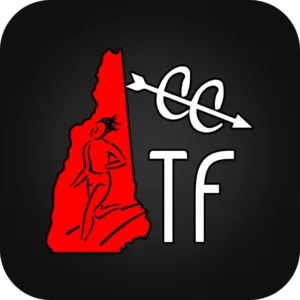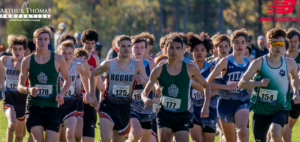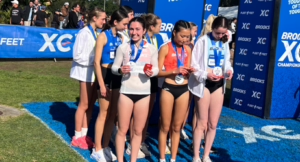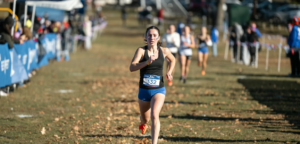Identity
In 1990, my parents bought a house on Lyndon Street in Concord. I was only a year old when we moved. In the four years we lived on Lyndon Street, I spent hours in the jog cart as Dad pushed me down the road on his runs. I only know that happened because my parents told me it happened, I don’t remember those runs. So, of course, I didn’t know what indoor track, outdoor track or cross-country were.
I do have some memories of the years we lived on Lyndon Street. In particular I clearly remember the “old” people who were our nextdoor neighbors. Bill and Marge were white haired and bright eyed people full charisma and big smiles. They lived in a large square house painted a deep navy blue. In their backyard was an incredible vegetable garden. Bill and Marge were multi-talented people. Bill, in addition to his green thumb, was a talented artist. He carved and painted birds so beautiful and lifelike it would have made James Audubon jealous. Later I learned Bill also was responsible for firing the starting pistol at a five mile road race held every July in Concord. The winner, I’m told, used to be presented with one of his birds.
 When I started running cross-country as a freshman at Concord High school I learned that my former neighbor used to be known as “Mr. Luti” and “Coach Luti” when he was a teacher at Concord High and the boy’s cross-country coach. It was during his time as cross country coach, that the team’s championship banner in the gym grew full.
When I started running cross-country as a freshman at Concord High school I learned that my former neighbor used to be known as “Mr. Luti” and “Coach Luti” when he was a teacher at Concord High and the boy’s cross-country coach. It was during his time as cross country coach, that the team’s championship banner in the gym grew full.
Four years later, I met my college coach, Al Fereshetian, for the first time. I told him that I had gone to Concord High. Coach “Fresh” then shared with me that he was a graduate of Bishop Brady High School and that Bill Luti had been a great inspiration to him throughout his coaching career.
After graduate school, I accepted a position teaching social studies at Concord High School. A year later I had a chance to do something my neighbor of years past had once done – coach the boy’s cross country team. Coach Luti is a legend. It is no surprise that he was an inspiration to my college coach and many others. During Luti’s twenty-five years (1957-1981) at the helm, Concord’s harriers won thirteen state championships. Additionally, Coach Luti’s teams claimed four New England titles.
Among all of his great teams, it is 1963 team that stands out as the best. They are the last team to sweep the top five places at the state championship. They also went on to win the New England Championship with an impressive low score of 48 points and their number one runner, Roger Maxfield (Current NH State Official) took home the individual crown.
Last summer I had a chance to read “Luti’s Boys”, written by another member of the great 1963 team, Bob Estabrook. You cannot read what Estabrook has written about those years without wondering what powered those teams on their remarkable run of success. Executing a sweep in a state meet and winning three New England Championships in a row are truly unique achievements – even in a state that has seen many great performances over the years.
What was their secret to success?
Understanding the nature of success is the central challenge of all sport. Success shapes our character and then our evolving character re-shapes what success means to us in turn. Our understanding of success then determines the possibilities that will await us. Some will explain that success flows from some combination of talent, training, ability, alacrity, potential, willpower, sacrifice, desire, and focus. Certainly conventional wisdom tells us that the answer to the success question must be one, some, or all of those.
Conventional wisdom is, sometimes, wrong.
Those traditional explanations are merely symptoms of success, not causes. Just as leaves do not make a tree, those characteristics do not make success. To understand success we want to understand its cause. To understand cause you need to find the roots.
In the last five years we (Concord Boys XC) have changed a lot as a team. In 2014 our team averaged 18:17 at the State Meet to finish sixteenth. In 2017 our top five averaged 15:53 at the Meet of Champions. A simple explanation would be to say that the 2017 team was better. While this explanation identifies a symptom, it does not identify a cause. I don’t think the difference is that the 2017 runners were “better” than the 2014 runners. Yet something is clearly different. We believe the change that we experienced was a change in our identity. There are many things that are different in our locker room, our workouts, and at the starting line. But the change is best shown through one specific, seemingly insignificant detail.
 Shorts.
Shorts.
In 2014 nobody wore running shorts to practice. Everybody wore shorts that were knee length or longer. We could have been any sports team doing conditioning as we ran up and down the streets near the high school. Now, everybody wears running shorts to practice. The identity of the team has changed. Those shorts are not the sign of being weird, or different as they were for the 2014 team. The shorts are a part of who we are and who we strive to become. We have a clear sense of identity – we are runners first and foremost.
We also know that our sport, and the commitment we make to it, will not always make sense to others. But we do not allow the skepticism of others to limit us. That is why we have come to call ourselves “TRIBE”. Each member of the team knows that we are here to support our teammates as we work towards our goals. We understand that it is important to set aside the criticisms and doubts of others. Bill Luti used to tell his runners that cross-country was a minor sport, but it would be a major sport for those who participated in it. We embraced this idea – for us cross-country is a major part of life.
As for the secret to the success of Bill Luti’s team? Well, the answer is in hidden in plain sight, in Estabrook’s title, “Luti’s Boys”. They knew who they were and they were proud to have a chance to belong, proud to be a part of something that others had contributed to, and proud to contribute to something that would last into the future. They had a clear identity. They were Luti’s Boys.
Success, then, flows from identity. The identity that we cultivate is the root of everything else we do. Talent, training, ability, alacrity, potential, willpower, sacrifice, desire, and focus are the leaves. Identity is the root. When all of these elements are fully alive and combined with a clear identity we have a chance to craft our moment of excellence.
You don’t have to win races or post the fastest times to be a great runner. To be great, you need to keep searching for limits and find ways to move past them. We know that limitations, in our own mind or in the minds of others, are like a storm. While individual leaves will not weather a storm, strong roots can reach deep and hold strong in the face of the fiercest adversity. When you build an identity as a runner you have the chance to change who you are. The hunger for new challenges that test our ability to endure can push us all forward on our quest to become something great.
Success is not a recipe, it is a landscape.
Build your identity, craft a landscape in which you can thrive. In that space you can become a runner and you can become the best possible version of yourself.
– Coach Bling
During the 2017-2018 indoor season, I was having the hardest and worst season of my running career. I was never satisfied with how I ran each race or what my results were. I was struggling with some of the training sessions and I don’t think I finished a single workout all winter.
After running a five minute mile at Dartmouth Relays, in which I remember being passed by almost everyone in the race, I had a long talk with my coach about why the results weren’t coming and why I wasn’t having a good season. We came to the conclusion that my training was not consistent. My training pace on each run was inconsistent. Often I was not covering the desired distance and would stop or turn back early. We decided that over time, if I could become more consistent in my training and patient, then slowly I would not just become a stronger runner but I would also get the big results I was looking for.
As I started being more consistent with my training between the winter and spring season, Coach Bling and I were able to set reasonable goals for outdoor track and discuss what I had to do to achieve the goals. After a few months of great training I was able to not just achieve my goals but also exceed them and have the best season of my running career so far. This past spring season, during each workout, I found I was more and more motivated. I felt more mentally tough than ever before. I was up for any challenge that Coach Bling would throw at us.
That is what made me realize that I am a runner and I have what it takes: the mental toughness, the will power, the motivation. Now I fully embraced my identity as a runner.
I haven’t always been a runner.
I didn’t even feel like I was fully a runner until last fall. Sure, I have been running since sixth grade, but most of the time it was only when I was forced to do so. I didn’t understand why some people find the sport so enjoyable.
Today I am a convert.
The process really started my freshman year when Bling became my coach. On the Concord team I began to feel that being a part of this team was going to be different than other teams I had been a part of. I also knew we were going to achieve greatness.
But, to be honest, my freshman year I still wasn’t anything special. At the end of outdoor track that year, I had a conversation with Coach which he always likes to reminds me of. At our last meet I had run another unimpressive time and I was tired of performing at that level. So, I went to my coach for some advice – could I do anything to become a good runner? He said that he knew I could and suggested that if I continued to train through the summer, I would see a big improvement in the fall.
Well, I didn’t really train that summer and when I came back for fall training I paid the price. I suffered in training. I came home from practice everyday with my legs tired and my body ready to collapse. But, instead of giving up, I endured. That year, by the end of the season I was the fourth man on the team. I was moving up in the world. My improvement during that season motivated me just enough to do about half of the training plan the following summer. With that little boost in commitment my running career became exciting. Now I was running times on par with the fastest New Hampshire guys, culminating in a runner-up finish at the State Meet.
The key to my improvement was committing to the process.
The first half of my high school career, I thought I knew best, as most teenagers do, but really I just needed to step into line and start shouldering the weight of training. I am not blessed with natural ability as many others are. My strength is my ability to endure, to push through my training to get results. In doing so I have become a runner.
Over the past few years I have learned to endure because of the support of my team. Now I grind along the roads and trails day after day. Sometimes I train in freezing temperatures. Sometimes I train when the rest of the country is at home sitting in front of the air conditioner.
If you don’t understand what’s so joyous about running then maybe you still need to find your inner runner.
Identity is arguably the most important aspect of life. Who are you today? Who do you want to be tomorrow? There comes a time in every young man’s life when they will have to make a decision that could alter their future. In my case, it also altered my identity.
During my freshman and sophomore year at CHS I ran cross country in the fall, wrestled in the winter and ran track in the spring. I found success in each sport. Sophomore year at the Meet of Champions for each season sport I was 10th in cross country, 3rd in wrestling and 6th in the 3200m during outdoor track. At first glance that would make it appear as though I was a better wrestler than I was a runner. This became one question to mull over – was I having more success as a runner or as a wrestler?
Another question came from looking at what each of those results meant to me. The placings were solid, but not excellent. What should I do? Should I accept solid results for the rest of my high school career? Or should I try to focus on one thing and try achieve excellent results? I knew coming into high school that this decision would be hard. I made a deal with Coach Bling my sophomore year. If my name was at the top of the results sheet at the Division 1 State Championships in October, I’d pull the trigger and focus on my running.
If only it was that simple.
Once cross country had reached its end, it was time to consider the winter season. The past two years I belonged to the TRIBE (running) and to the Brotherhood (wrestling) – two families that I had made unbreakable bonds with. I lost a great deal of sleep due to stress as I thought about the decision as the wrestling season started. To handle all of the built up stress, I went running. On one of these runs, I had an epiphany.
It was only a short jaunt along the rolling dirt roads of Deerfield. Winter wind froze my breath into ice crystals on my eyelashes, making it impossible to see. I was wearing my beat-up trainers from the cross-country season, the tread worn smooth, so I slipped and slid on the snow. My legs turned pink, a result of my “it’s not that cold out” mindset that had me outside in my shorts instead of my pants. A cramp started to knot just above my shoulder. I stopped running for a moment and I reflected upon all the uncomfortable feelings I was experiencing in that frozen moment. I couldn’t see. My legs were burning with cold. My shoulder was pinched in pain.
It was suffering and it was beautiful.
I understood in that moment that this made me happy. This was where my heart was. Running will beat you to a pulp. Only the strongest survive. I thought, if I can love this suffering while running, I must really love the sport! I made my decision. I would leave the mat behind and take to the track and trails. My identity took a huge step forward in the right direction. Now, looking back, more changed for me in that moment than my winter sport. My understanding of success, how it looks and how it is created, has completely changed.
Let me offer some wisdom. I have had some awesome racing experiences in high school. I’ve won a lot, and I’ve lost a lot. That’s what happens in the sport. If you reach the highest level you can beat ninety-nine percent of people. But there will always still be the one percent that can, and will, beat you unless you have your best race. Last year I had to battle with and chase down David Vorbach during cross-country, indoor track, and outdoor track. Vorbach had better times on the track. He was older, stronger and hated to lose more than anyone. He was just faster. Last year he was that one percent. Every race I competed in, regardless of whether he was in the race, I thought about beating him. I was able beat him at some of the biggest meets in cross-country. But he beat me on the oval.
It would be easy to say last year I ran the most that the most successful race of my life: the Division I Championship in cross country.
Let me tell you about a different race instead. The 3200m at the Meet of Champions in outdoor track was the grand finale in my rivalry with Vorbach. Early in the race we separated from the chase pack and built a twenty-second lead over the field. It was just the two of us battling around the track. I sat on his shoulder and made two foolish moves in the last 500m which may have cost me my chance at winning, but that’s racing, you will make mistakes. In the last 200m I closed down the slight gap he had on me and then we were running all out, neck and neck down the last straight. As I neared the finish line, I fought with every ounce of strength I had to go faster to inch ahead by the line. As we approached the line I leaned. Then I fell.
I lost.
For a whole year I trained to win this race only to finish 0.16 seconds shy of my goal. Yet, this was without a doubt my most successful race.
Success is not derived from the numbers next to your name in the race results. Success comes from the satisfaction of knowing you couldn’t have worked harder. It comes from preparing yourself to be in the position where winning becomes a possibility. It comes from any time you can shape your identity. I wouldn’t have been in that position to be kicking for the line with him had I kept wrestling. I would’ve been back in the chase pack hoping to place well enough to make it to New Englands.
That is the beauty of running! It is self-run (no pun intended). Along the way there are many people you will meet who can contribute to your identity and your success. However, at the end of the day, you’re the one taking the steps to reach the next level. You are the one doing the work and you are the one who benefits. The questions remain.
Who are you today?
Who do you want to be tomorrow?















3 Responses
Wow! What an awesome piece. Nice insightful wisdom from the young bucks, including Coach Bling. Amazing what can be accomplished when you embrace the sport and fully become a runner, not just someone who runs. Nice work boys!
There are many times I’ve had the opportunity to witness Forest do some very impressive things in running. He is one of the most forward, honest kids I’ve ever met through this sport. Having conversed with him on many occasions I feel I have a pretty good idea of his character but this eloquent piece of writing, his openness on what makes him great only adds to my humble opinion of him. What a great inspiration
Coach Bill Luti migrated from Massachusetts in the mid to late 1950’s to Concord, NH bearing a technology later known as interval training. Possessing an iron will that was manifest in his profile and demeanor, he proceeded to alter the course of distance running in NH for decades. With a personal style more akin to a Zen master than a loquatious English teacher, he motivated aspiring athletes to achieve levels of performance far beyond what they believed possible. His words were straight forward, issued as edicts and mantras to returning runners and novices alike: “If you smoke and drink, you must quit; Champions do all the little things right; Concord runners are never seen walking, you must run to and from Whites Park; There is no substitue for hard work.” When confronted with runners failure to commit to these tenets, he said “Champions are made of stronger stuff than this.” What also exemplified his team spirit was the practice of the top runners cheering on the rest of the team as they approached the finish line, right down to the last man.
I joined a Boy Scout troop to which Gerry Love also belonged. In 1964 he urged me to join the Concord High cross country team. So I had the honor of working out with that team for about two weeks. The problem was that I was a ninth grader and according to Rundlett Junior High coach Martin, “We only allow very exeptional athletes to participate in senior high school programs. But those 2 weeks were filled with Coach Luti’s wisdom, encouragement, and vigorous workouts. Doing quarters around the duck pond in Whites Park became a habit, routine and almost way of life for the next 3 years. The sound of his voice resonated as he called out the 220 split and the quarter time as you passed by the figure bearing several stop watches and clipboard. Among the many other sights and sounds at the park there was Gerry Love yelling out, “Da da da da da da… THREE.” That represented the quest for a third straight New England championship win. And indeed that November I travelled to Rhode Island and heard the team yell out that call at the beginning of the race and watched some official after the race hand the winner’s trophy to Coach Luti and the team.
I came across this blog/article/essay quite by accident. I was looking for any results that might be posted for the 2018 team. I first read about the Nashua Invitational and just said to myself, “wow.” And then I came across this site. After the first reading my mouth just hung open for a while. It brought out memories and feelings long buried. Coach Bling, what your writing represented to me was a restoration of that tradition, an ethos and tradition I thought was lost and long forgotten. When I joined the team as a sopohmore in 1965, there was a sense of being a part of something very special, of having been handed a precious legacy. It also became a weight that I and others gladly carried from season to season. As one learns from victory, so one learns from defeat. In 1965 we won the state meet but placed 5th at the New England meet in Boston’s Franklin Park. The Massachusetts teams were very strong and led by Randolph’s Art Dulong, argueably one of the best ever. It takes a long time to adjust to such a loss. The 1966 season gave the team its first dual meet loss after 41 consecutive wins. The Saturday after that loss, Coach Luti showed up at Whites Park unshaven and in a somber mood. His first words were, “If anyone says we would’ve won if Kendall, Woods and Auger (3 in the top 7) had run, I’ll punch ’em in the nose.” That was his way of saying “no excuses; let’s move on.” That year we placed 3rd in the state meet and fortunately that was enough to get us to the New England meet where we placed 6th. At this point the returning runners knew there was only one path for us: an undefeated regular season, followed by another state championship, followed by a New England title. At the end of 1967 we attained the first two and got the runner up spot in the latter. Coming in 2nd place at the New England meet stays with one for a lifetime but it cuts both ways. most importantly our striving propogated that Concord High tradition, that Coach Bill Luti ethos that you so aptly describe as “Identity.”
Thank you, Coach Bling, for what you have done and waht you are now doing.
Sincerely, Jon J Kendall
Post script:
I am a practicing criminal defense attoreny in Southern Calfornia and still run. I am in the 1967 picture above, behind Walt Chadwick to the left. Jack Nelson is on my right. Regarding your lesson on shorts, I felt the same about shirts. You will notice our shirts worn in 1967 were tee shirts, not tank tops. Roger Maxfield’s 1963 team wore those same tee shirts and I always admired them over tank tops. In 1965 we wore the tank tops, but in 1966 I bought a dark brown tee shirt and put lettering on the front: Harriers. I asked Coach Luti if I could wear it in races. He agreed. The next year he ordered the tee shirts for the top 10, I believe. Each runner got to keep his numbered tee shirt as long as he averaged that spot. Finally I have a Lyndon Street conncetion. My girlfriend during my junior year lived directly across the street from Coach Luti!